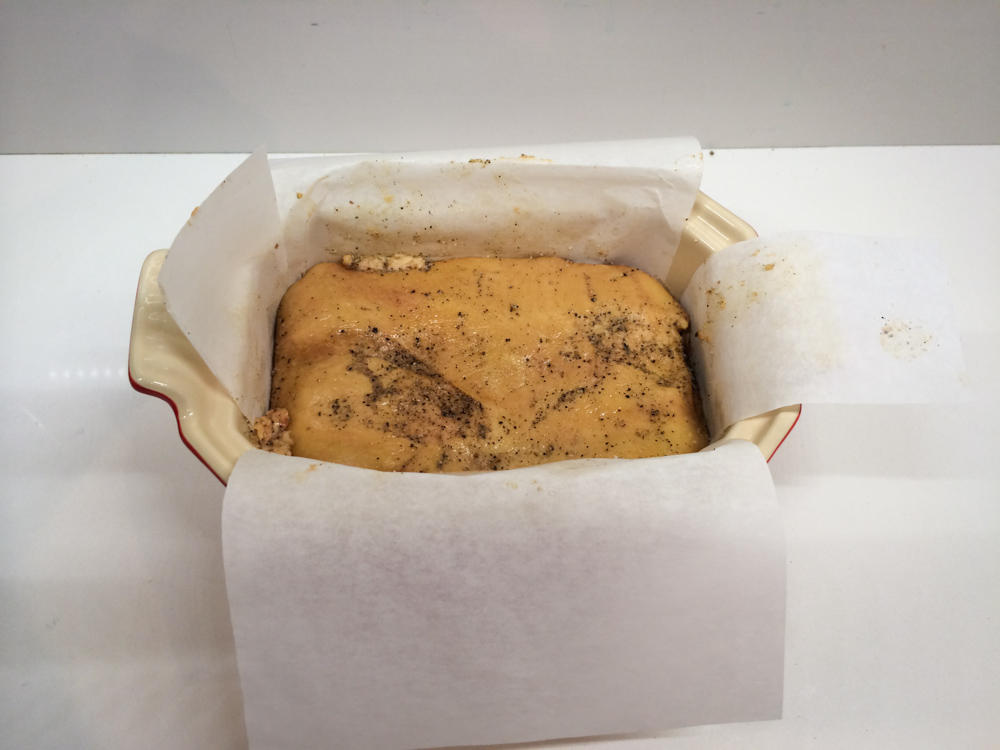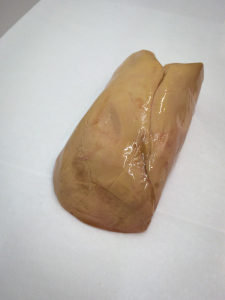Foie Gras Terrine

 Foie Gras is one of those dishes that people seem to be uncomfortable making. But it’s actually really easy. During the holidays, Foie Gras is seen every where. It’s one of those french staples during the holidays. Up north, where my family lives, there is usually a terrine that is passed around before we sit down to eat. We make up some toasts and this year I made an onion compote and sauternes gelée to go with it as well.
Foie Gras is one of those dishes that people seem to be uncomfortable making. But it’s actually really easy. During the holidays, Foie Gras is seen every where. It’s one of those french staples during the holidays. Up north, where my family lives, there is usually a terrine that is passed around before we sit down to eat. We make up some toasts and this year I made an onion compote and sauternes gelée to go with it as well.
Foie Gras is the liver that comes from a duck or goose that have been fattened, usually by force feeding but there are farms where they are fattened naturally. “Foie gras belongs to the protected cultural and gastronomical heritage of France.” according to french law.
I could eat Foie Gras everyday, but having it every now and then makes me enjoy it that much more. Although too much can’t be that good for you! Plus, it can be on the pricey side at around 23€ for 500 grams (or a little more than 1 pound). You’ll also need to plan ahead as it takes a least 2-3 days for everything to come together and set and the seasonings to permeate the liver. This terrine served 2o of us so it can go a long way.
One thing that you may want to consider purchasing if you don’t already have one is a terrine mold with a press. If you have one without the press, it’s easy enough to cut a piece of cardboard to fit inside your mold. Wrap it in, keeping it as smooth as possible and then wrap that in plastic film. One thing you don’t want to do when it comes to Foie Gras is have it come in contact with aluminum foil as the foil will discolor the Foie. Once you have your press, you can weigh it down with a can. When cooking Foie Gras, all you really need to be concerned with is the final cooking temperature. As long as you hit 52°C or 126°F, you’ll be set.
As I mentioned, Foie Gras is usually served with some type of compote to help cut through the richness of the dish. I’ll post a recipe for a sweet onion compote soon.
Think about adding a Foie Gras dish to your picnic. If you’re looking for a traditional french dish, this is a great option. Also, for the month of February, my wife Lindsey and I are offering a Valentines Month special.
- 1 lobe of Foie Gras weighing around 500-550 grams
- Foie Seasoning used at 17g per Kilo of Foie (time to bust out the calculator)
- 12g Salt
- 2g Sugar
- 3g Black Pepper
- Splash of Cognac
- For the Foie Seasoning:
- Combine Salt, Sugar and black pepper. Measure out how much you’ll need (i.e. 8 or 9 grams for around 500-550 grams of Foie.
- For the Foie Gras:
- Allow the lobe to come to room temperature for about an hour so that it’s somewhat soft. De-vain the lobe of Foie Gras. Season the Foie Gras with the measured out spice blend. Place into a parchment paper lined terrine mold with the smaller pieces first. (The parchment paper will help to remove the terrine from the mold once the Foie has set.) Add a splash of Cognac and then the largest piece on top. Press firmly into the mold to remove any air pockets that there might be. Put it in the fridge for an hour and let the seasonings mingle for a bit.
- Pre-Heat your oven to 180°C/350°F
- Place the terrine mold into a roasting pan or casserole baking dish. Add warm water to the pan so that it comes half way up the side of the terrine. (This is called a Bain Marie) Place this into the oven for about 40 minutes. Check the temperature of the center of the Foie. You’re looking for a core temp of 50°C/120°F, with carry over cooking, you can pull the dish out and it will hit the 52°C/126°F mark.
- Let the dish cool for about 15-20 minutes. Then you’ll add the press to the dish so that the fat rises to the top. Don’t press too hard. Place the mold into the fridge and let it set overnight.
- The next day, remove the weight from the mold and remove all of the congealed fat and place it into a small pan or pot. Melt the fat back down and pour it over the Foie Gras in the mold. This will conserve the Foie Gras until you are ready to eat it. If will last up to 3 months in the fridge if this is done properly. If you are looking to eat it quickly, you can omit the step of melting the fat down and pouring it over to seal the Foie Gras.
